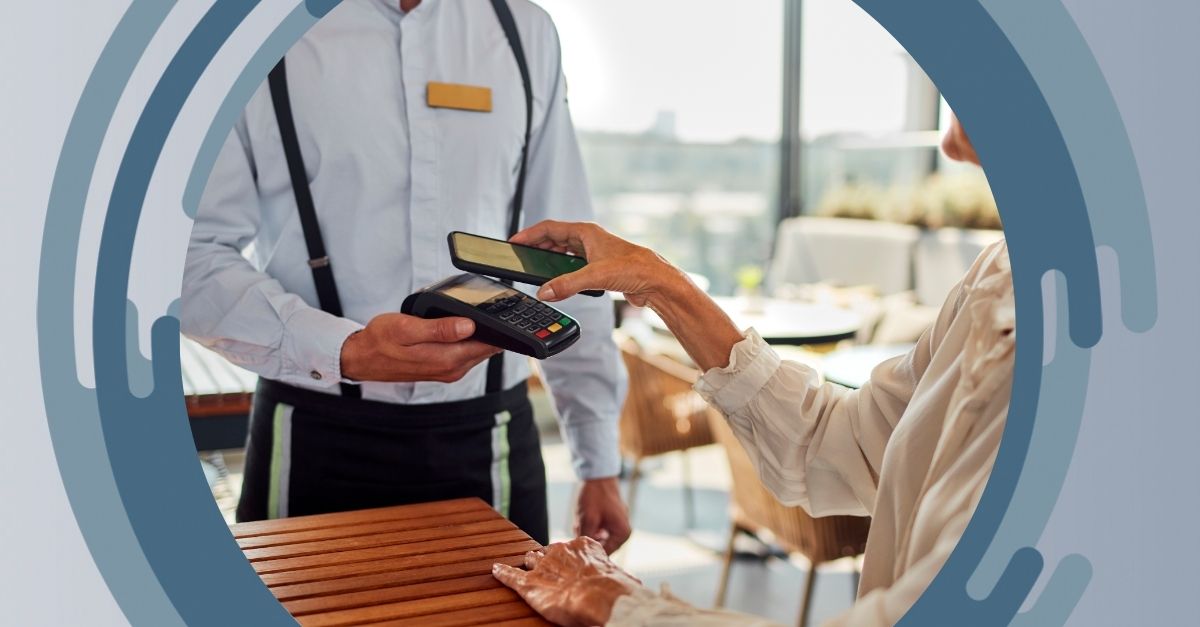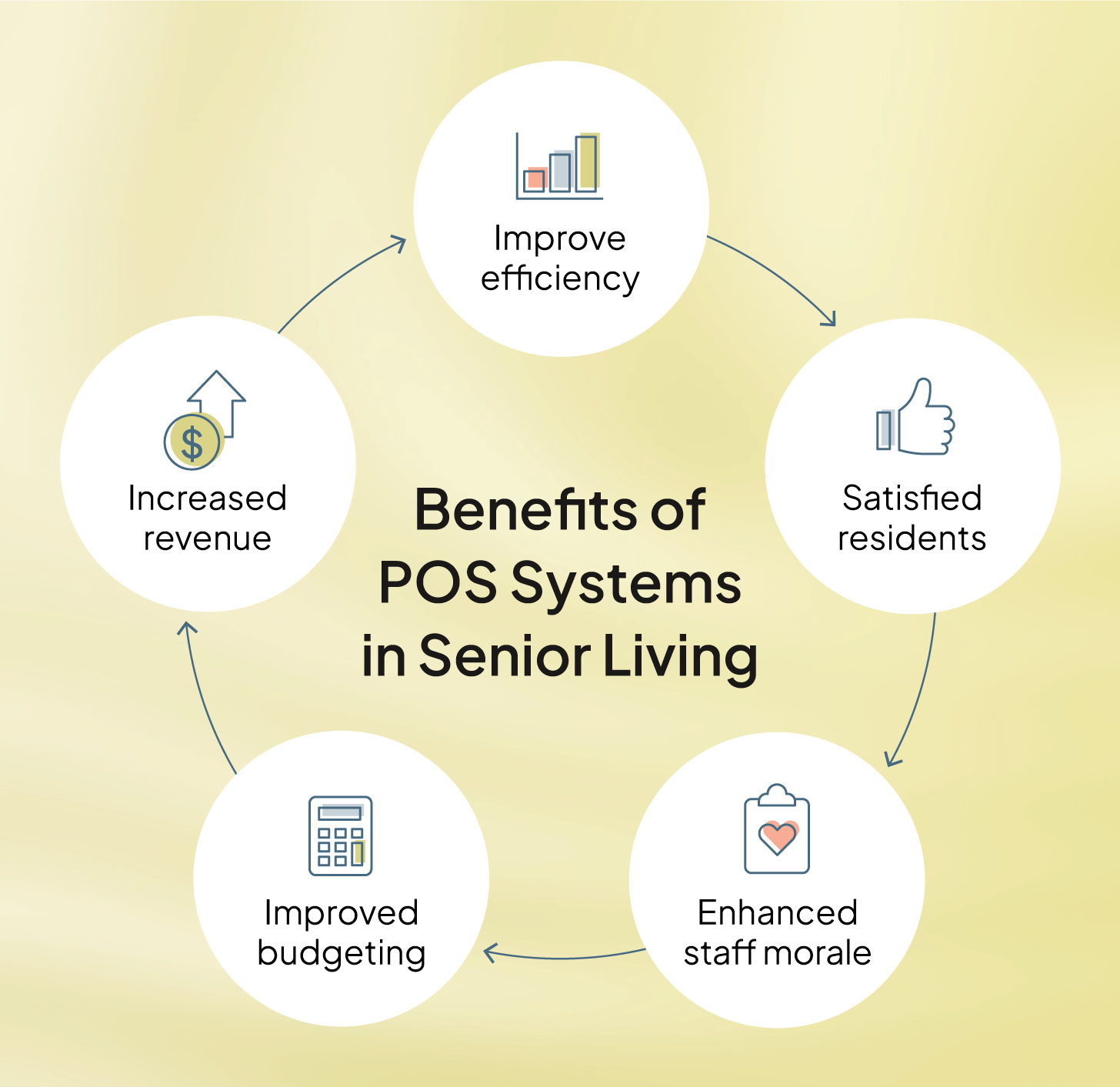Streamlining Senior Living Dining: Your Guide to Incorporating a POS System
Enhance efficiency, accuracy, and resident satisfaction by integrating a POS system into your senior living dining operations

Enhance efficiency, accuracy, and resident satisfaction by integrating a POS system into your senior living dining operations
Published on: August 22, 2025
Last updated: October 22, 2025

Creating a smooth, satisfying dining experience plays a critical role in enhancing residents’ quality of life. For senior living community owners and operators, that experience must be balanced with operational efficiency, cost control, and resident satisfaction, all essential for long-term success.
One of the most effective ways to meet those goals is by implementing a point-of-sale (POS) system. When thoughtfully integrated, a POS system not only supports smoother meal ordering and service, but it also provides the foundation for better financial tracking, inventory control, and resident engagement.
So what does successful POS integration look like in practice? Let’s explore how senior living communities can bring this technology to the table and the impact it can have across dining operations.
Introducing a POS system into your senior living community brings both measurable operational gains and meaningful improvements in the resident experience.
According to our State of the Industry Report, operational efficiency is the top revenue growth opportunity in 2025, underscoring the need to streamline processes wherever possible. A POS system plays a key role in this by modernizing core dining service workflows, such as order-taking, payment processing, and kitchen communication.
With a senior living–specific POS solution, staff can take orders more quickly using intuitive touchscreen interfaces on mobile tablets or smartphones. Orders are transmitted instantly to the kitchen — no need for handwritten tickets or verbal relay — minimizing delays and reducing the risk of errors.
POS systems also simplify payments by allowing transactions on connected tablets. During high-volume meal periods, this means faster checkout times and reduced bottlenecks.
Even better, residents don’t need to worry about pulling out a card or cash. POS systems integrate with resident accounts and meal plans, enabling seamless tracking and reconciliation behind the scenes.
Perhaps most importantly, kitchen communication becomes significantly more efficient. Orders go directly from server to prep station in real time, reducing the chances of misplaced or forgotten requests. This leads to faster service, more accurate meals, and a more organized kitchen environment.
For communities looking to unify dining operations under one system, solutions, such as Grove Menus by Aline, offer integrated POS capabilities tailored for senior living, combining menu planning, resident preferences, and streamlined order processing into one cohesive workflow.
Senior living owners and operators need access to accurate data, but according to our State of the Industry Report, only 25% report having complete access to the data they need, and nearly half say they lack sufficient data altogether.
In dining services, accuracy powered by data directly affects resident satisfaction, health outcomes, and your community’s financial and compliance integrity. Implementing a POS system helps improve accuracy by reducing errors in orders and billing — two areas where even small mistakes can have large impacts.
By digitizing the entire ordering process, a POS system ensures that what a server enters is exactly what the kitchen prepares. This minimizes common issues, like incorrect dishes, missed modifications, or inaccurate portion sizes.
On the financial side, POS systems eliminate invoice discrepancies that often arise with manual tracking. Resident accounts, meal plan balances, and additional charges are updated in real time, ensuring families are billed correctly while your community captures all revenue without gaps.
Advanced systems — like the one built into Grove Menus by Aline — go a step further by integrating dietary profiles directly into the POS workflow. For example, if a resident has a severe nut allergy, the system can block incompatible menu options and alert kitchen staff to allergy-sensitive orders. This not only protects resident health but also supports your team in providing personalized, compliant care.
The digitization of dining operations brings with it a powerful advantage: access to enhanced data and reporting. A POS system does more than process transactions — it becomes a central data hub, capturing and delivering valuable insights across every part of your dining services.
These insights can include:
Armed with more than just basic accounting figures, your leadership team can make real-time, informed decisions that improve operational performance. According to our State of the Industry Report, many operators rely on robust, custom reporting to guide financial strategy — yet 16% say their current reporting tools are “cumbersome.” A well-implemented POS system simplifies this process, offering easy access to the metrics that matter most.
These data capabilities translate into direct operational impact. For example, by analyzing peak dining hours, your team can strategically adjust staffing levels to reduce wait times and improve service — ultimately enhancing the resident experience.
One of the most impactful benefits of incorporating a POS system into your senior living community’s operations is the ability to streamline billing. A modern POS system simplifies and automates resident billing and guest payment processing, reducing administrative burden and increasing accuracy across the board.
Manual billing is notoriously time-consuming and error-prone, often leading to discrepancies that frustrate residents and staff alike. In fact, our State of the Industry Report found that 41% of respondents struggle to align financial data with billing, resident management, and operational tools due to poor system integrations. Inconsistent or manual processes can even lead to revenue leakage, putting a community’s financial health at risk.
With an automated billing process, a POS system ensures that every transaction is accurately recorded and applied. Resident accounts and meal plans are directly integrated into the system, eliminating the need for staff to track charges manually.
This functionality becomes especially valuable during special events, like birthdays or family celebrations, when residents host guests. With a POS system, staff can either apply guest meals to the resident’s account or process payment on the spot, just like in a restaurant. The result is greater transparency, fewer billing questions, and a smoother experience for everyone involved.
Better inventory management is a game-changer for senior living dining services, and a POS system is the key tool to achieving this. A POS system provides real-time ingredient tracking, allowing you to minimize waste and optimize ordering.
Inventory management becomes critical in an environment where food expiration costs can add up, and you must meet many different dietary needs with each meal. Integrating this function into your POS system helps track which ingredients are being used and how much is used for an accurate look at inventory at any time. This eliminates the guesswork of inventory management and allows for accuracy.
In senior living communities, one of the most critical yet often intangible success metrics is resident satisfaction. While difficult to quantify, it has an undeniable influence on occupancy, retention, and reputation.
A key takeaway from our State of the Industry Report is that the senior living sector is increasingly embracing technology-driven solutions to improve efficiency, enhance care, and simplify communication, all with the ultimate goal of elevating the resident experience.
Dining services play a central role in that experience. As personalization becomes a defining trend in senior living, the ability to tailor meals to individual needs and preferences is no longer a luxury — it’s an expectation. A POS system helps meet this demand by enabling faster service, ensuring meal accuracy, and accommodating customizations at the point of order.
The benefits are especially felt by residents who follow specific schedules or have strict dietary restrictions. With a POS system in place, they no longer need to worry about meal delays or ingredient errors. Instead, they enjoy greater peace of mind, improved nutritional safety, and a more dignified dining experience.
Technology, like a POS system, empowers residents with more control and choice, key elements of well-being in modern senior care. For instance, a gluten-intolerant resident can filter menu options to view only gluten-free selections or dishes with safe modifications. This level of personalization transforms dining into a moment of enjoyment and autonomy, not limitation — more like a fine-dining experience than a cafeteria line.
Successfully implementing a POS system into your senior living community’s dining services requires thoughtful planning and alignment with your unique operational goals. A well-chosen system can reduce administrative burden, enhance the dining experience, and ultimately drive higher resident satisfaction.
To ensure a smooth transition and maximize your return on investment, consider the following best practices during rollout and implementation.
Seek staff feedback: Involve your dining and operations teams in the decision-making process to ensure buy-in and identify practical considerations early.
Many of your community’s dining-related administrative tasks, including ordering, billing, and reporting, can be dramatically simplified with the right POS system. Integrating Grove Menus by Aline into your dining operations helps reduce errors, save staff time, and create a smoother experience for residents and families alike.

Grove Menus by Aline eliminates a common frustration in senior living dining operations: disconnected systems that require manual updates every time a menu changes. With Grove Menus, the POS system is fully integrated with the core menu management platform, creating a seamless connection that simplifies day-to-day tasks for administrators and staff alike.
Daily menus, special items, and dietary adjustments sync in real time with the POS. Whether a dietitian makes a last-minute change or an ingredient runs out unexpectedly, updates are instantly reflected at every touchpoint — no manual re-entry required. This synchronization also extends to production data and resident-specific information, ensuring that every meal is served with both accuracy and efficiency.
For operators, this integration reduces administrative overhead and minimizes the risk of human error. Staff spend less time on data entry and more time delivering an exceptional dining experience.
Designed to work seamlessly with your existing hardware, including Apple and Android devices, Grove by Aline allows your team to place orders and run reports using tools they already know. This familiarity reduces the need for extensive training and speeds up onboarding, making it easier to get up and running quickly.
Leveraging your current devices also lowers the cost of adoption. Whether continuing with what you have or upgrading selectively, this flexible approach makes implementation more accessible while empowering staff to deliver efficient, high-quality service to residents.
Grove Menus by Aline features a truly user-friendly interface, built with intuitive navigation, clear visual cues, and streamlined workflows. The result? Minimal training time and faster adoption, so your staff can focus more on the resident experience and less on learning new technology.
For senior living operators, an easy-to-use system translates to quicker ROI, fewer errors, and faster task completion. It’s a smarter, simpler way to elevate your dining operations and improve the overall resident experience.
Data tracking capabilities built into Grove Menus by Aline elevate menu planning for senior living from a reactive chore to a strategic, insight-driven process. By capturing resident selections, preferences, and feedback through the integrated POS, the system provides actionable data to guide more thoughtful and effective planning.
With greater visibility into resident behavior, operators can fine-tune menus to boost satisfaction, reduce food waste, streamline staff workflows, and ultimately improve financial outcomes.
Learn more about incorporating a POS system into your senior living dining services with answers to common questions below.
Implementation timelines can vary based on several factors, including:
For smaller communities with straightforward needs, implementation may be completed in as little as four to six weeks. Larger communities or those with complex dining operations may require six to eight weeks or more.
To set your team up for success, it’s important to plan thoroughly, maintain clear communication with your vendor, and assign dedicated internal staff to oversee the rollout from start to finish.
A senior living dining POS system requires hardware to take orders, process payments, and relay information to the kitchen. Common hardware components include:
The exact hardware setup can vary depending on your community’s size, dining model, and existing technology, but most systems are flexible enough to work with standard, widely available devices.
Absolutely, a well-designed POS system is essential for supporting caregivers in managing dietary restrictions and allergy alerts. Many systems, including Grove Menus by Aline, integrate with resident profiles that capture detailed dietary needs and automatically cross-reference this information at the point of ordering.
This functionality is especially critical in assisted living communities, where residents often have complex medical conditions. As assisted living statistics reveal that 22% of residents require assistance with eating, precise and safe meal delivery is critical. POS systems make it easier for staff to care for these residents accurately and ensure they’re receiving exactly what they need.
The amount of training required depends on several factors, including:
With a well-designed, easy-to-use system, like Grove Menus by Aline, team members can typically learn basic functions, such as order entry and payment processing, in just a few hours of hands-on practice. From there, you can build out additional training for advanced capabilities, including managing resident profiles, applying discounts, handling returns, and running detailed reports.
Once you’ve selected the right system, incorporating a POS into your senior living dining services gives you the tools to enhance resident satisfaction, streamline operations, and maximize ROI. Grove Menus by Aline makes this transition seamless — empowering your team with intuitive tools, real-time data, and integrated workflows that support exceptional dining experiences from day one.
Ready to see what this could look like in your community? Let’s start a conversation about your dining goals and how Grove Menus can help you achieve them.


Amanda McGrory-Dixon
Amanda McGrory-Dixon is the content marketing manager at Aline, where she shares expert insights on how senior living communities can streamline operations, enhance resident satisfaction, and drive sustainable growth. With a deep understanding of industry trends and technology, she helps operators navigate challenges and implement data-driven strategies to improve efficiency, profitability, and care outcomes.
Blogs, stories and studies from the forefront of senior living operations

Lead generation surveys give senior living operators the data they need to understand their market, uncover new opportunities, and drive occupancy growth.

Prospect-centered selling helps senior living operators convert more leads and achieve occupancy goals through a more personalized, empathetic approach.

Gain insight into senior living pricing strategies for community success. Explore how Aline’s software optimizes revenue and operations

Overcome the biggest senior living financial challenges, including operational costs and occupancy rates, with interconnected software

Take a look at how senior living software options, like Aline, can elevate operations, resident care, and ROI

See how emerging dining strategies help senior living communities streamline operations while fostering stronger connections with residents
We’re using cookies on this site to improve your experience. Cookies help us learn how you interact with our website, and remember you when you come back so we can tailor it to your interests.
You can find out more about cookies and usage on our cookie policy page.
Some of these cookies are essential, while others help us to improve your experience by providing insights into how the site is being used.
For more detailed information on the cookies we use, please check our privacy policy
Your experience is important to us. We’re redirecting you to our new Aline website, where you’ll discover how our complete suite of senior living solutions can help you grow occupancy and revenue, optimize operations, and enhance resident care.
For more information, you’re welcome to read our statement on our merger. To continue your web experience, simply close this notification.
Your experience is important to us. We’re redirecting you to our new Aline website, where you’ll discover how our complete suite of senior living solutions can help you grow occupancy and revenue, optimize operations, and enhance resident care.
For more information, you’re welcome to read our statement on our merger. To continue your web experience, simply close this notification.
Your experience is important to us. We’re redirecting you to our new Aline website, where you’ll discover how our complete suite of senior living solutions can help you grow occupancy and revenue, optimize operations, and enhance resident care.
For more information, you’re welcome to read our statement on our merger. To continue your web experience, simply close this notification.
Your experience is important to us. We’re redirecting you to our new Aline website, where you’ll discover how our complete suite of senior living solutions can help you grow occupancy and revenue, optimize operations, and enhance resident care.
For more information, you’re welcome to read our statement on our merger. To continue your web experience, simply close this notification.
Aline Innovation Summit 2026: Registration Now Open!
Connect with senior living leaders, innovators, and industry peers May 11-13, 2026, in Frisco, TX to explore the latest innovations, proven strategies, and best practices shaping the future of senior living. View details and register today.